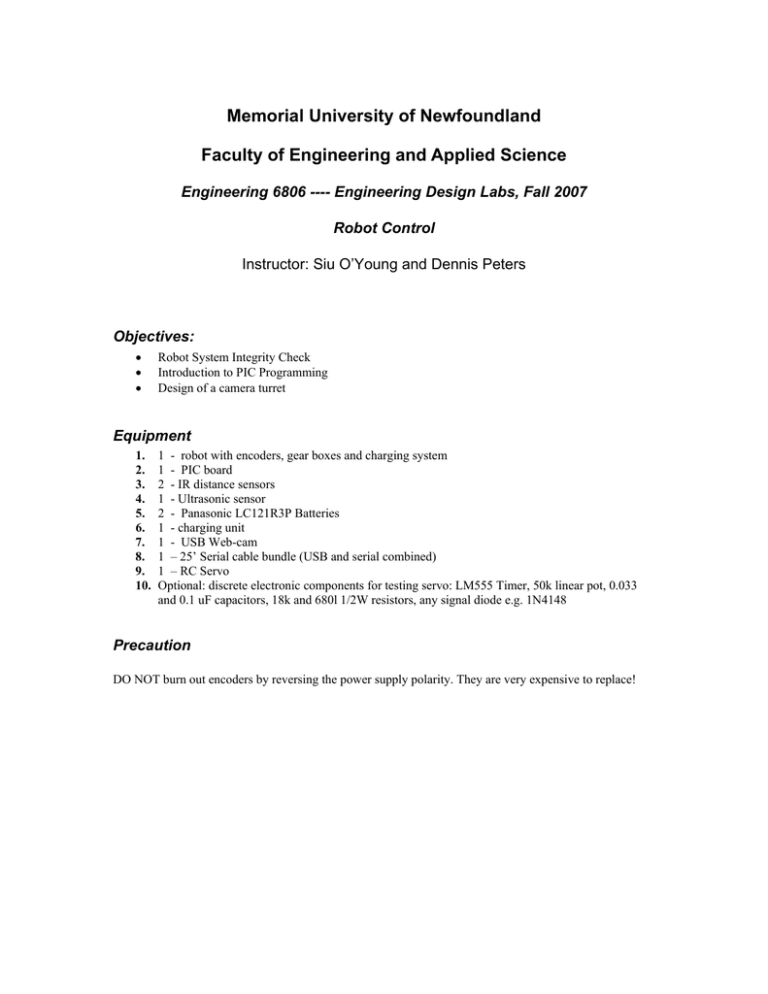Getting started with the robots - Faculty of Engineering and Applied
advertisement

Memorial University of Newfoundland
Faculty of Engineering and Applied Science
Engineering 6806 ---- Engineering Design Labs, Fall 2007
Robot Control
Instructor: Siu O’Young and Dennis Peters
Objectives:
•
•
•
Robot System Integrity Check
Introduction to PIC Programming
Design of a camera turret
Equipment
1.
2.
3.
4.
5.
6.
7.
8.
9.
10.
1 - robot with encoders, gear boxes and charging system
1 - PIC board
2 - IR distance sensors
1 - Ultrasonic sensor
2 - Panasonic LC121R3P Batteries
1 - charging unit
1 - USB Web-cam
1 – 25’ Serial cable bundle (USB and serial combined)
1 – RC Servo
Optional: discrete electronic components for testing servo: LM555 Timer, 50k linear pot, 0.033
and 0.1 uF capacitors, 18k and 680l 1/2W resistors, any signal diode e.g. 1N4148
Precaution
DO NOT burn out encoders by reversing the power supply polarity. They are very expensive to replace!
Procedures
Integrity Check of PIC controller board, motor and driver circuit
1. Power on the Robot and check that it will do the following self-check sequence:
• straight run in the forward direction for approximately 1 m;
• turn around and come back;
• clockwise spin around the center drive shaft for approximately 5 seconds
• stop
Use of the PIC C compiler and Bootloader
The PIC Controller board can be programmed via a PC serial port using the CCS-C
compiler installed on the desktop PC in the lab. The TA will give a demo on how to
compile the C source code and download the compiled hex code to the robot.
1. Modify the C source code for the integrity check so that the robot do the integrity
check sequence continuously.
2. Raise the driving wheels of the robot off the ground by using, e.g. a stack of
books, and run the robot with the modified program.
3. Measure the running time of the robot for a fully charged set of batteries. Recharge the batteries and repeat the test to get an idea of the condition of the
batteries.
RC Servo Control
If the camera is fixed mounted on the robot, the robot will have to rotate at some
waypoints in order to position the camera for reading the letters. A way to speed this
maneuver is to build a turret mounted on the robot to rotate the camera in stead of the
robot. A simple turret can be built using an RC servo.
1. Build an simple RC PWM circuit to study how an RC servo system works. A
sample circuit is given below, and you might have to change the resistor
values to get the range of the RC movement to the right scale. This circuit is
from “Servo Driver #4” posted on
http://www.uoguelph.ca/~antoon/gadgets/gadgets.htm. There is also useful
information on driving an RC servo using a PIC microcontroller on this
website.
2.
Write a PIC program to turn the RC servo 90 degree clockwise and 90 degrees counterclock.
The following is a sample subroutine written by Jeff Newhook. You can modify the Integrity
Check program as the main program to call this routine to get familiarized with your first PIC
programming.
/
*
* Turret routines
*
* Author: Jeff Newhook
*/
#define TURRET_PIN pin_c0
/
*
* Rotate turret
*
* Center: 1.5ms
* Left; 1.0ms
* Right: 2.0ms
*/
void TurretRotate(int degrees)
{
unsigned int16 delay;
int i;
//delay = (((degrees / (float)90) * (float)0.5) + (float)1.5) * 10000;
if(degrees == 0)
delay = 1400;
else if(degrees == -90)
delay = 2200;
else if(degrees == 90)
delay = 500;
printf("deg = %d delay = %Lu\r\n", degrees, delay);
for(i = 0; i < 5; i++)
{
output_high(TURRET_PIN);
TimeDelayUs(delay);
output_low(TURRET_PIN);
delay_ms(20);
}
}


